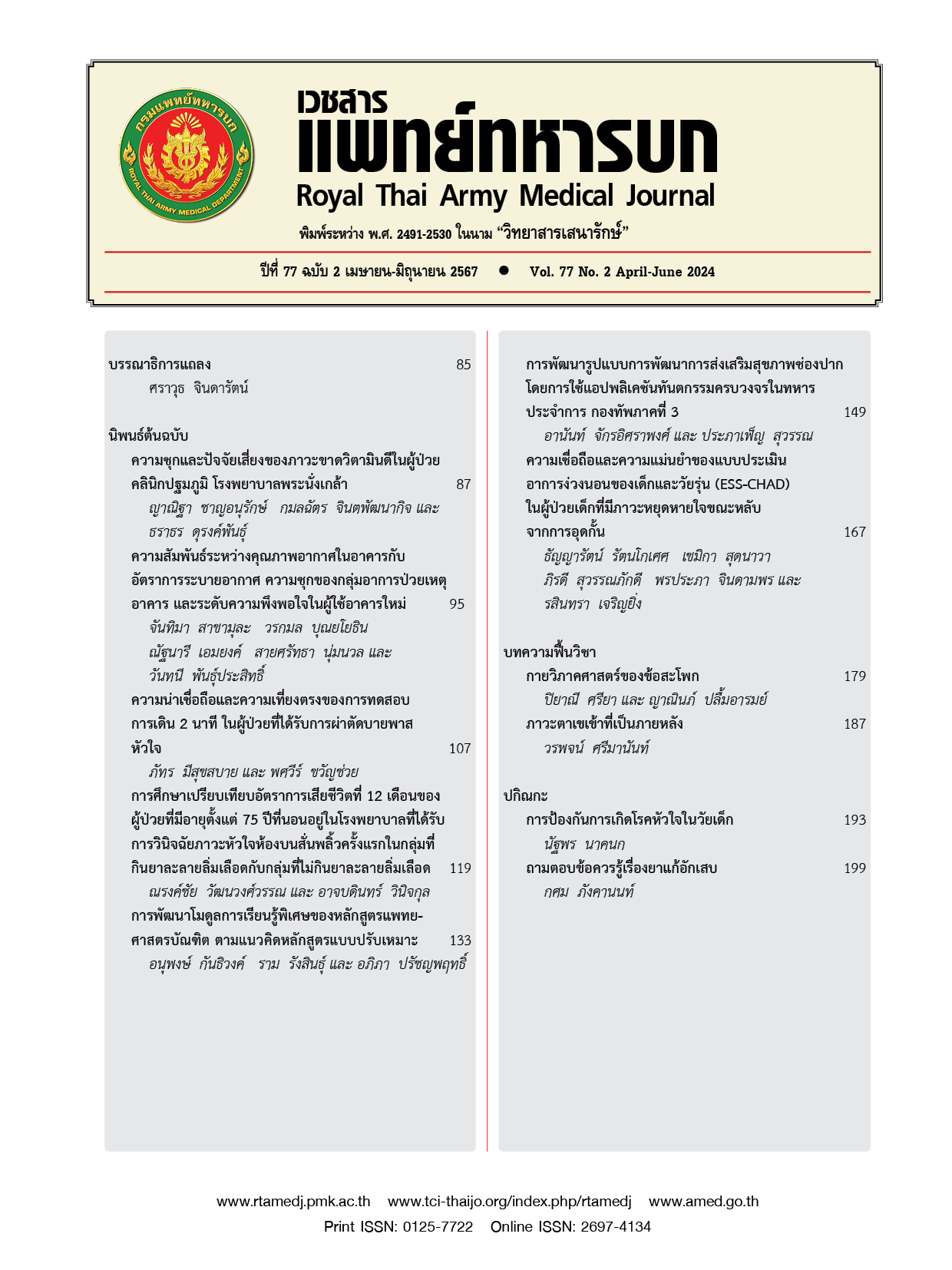ความชุกและปัจจัยเสี่ยงของภาวะขาดวิตามินดีในผู้ป่วยคลินิกปฐมภูมิ โรงพยาบาลพระนั่งเกล้า
Main Article Content
บทคัดย่อ
บทนำ วิตามินดี มีหน้าที่ในการควบคุมเมตาบอลิซึมของแคลเซียมและฟอสเฟต นอกจากนี้ยังพบว่ามีบทบาทสำคัญต่อภาวะ อื่น เช่น โรคหัวใจ โรคมะเร็ง และโรคไม่ติดต่อเรื้อรังอีกด้วย การศึกษาในต่างประเทศพบว่ายังมีผู้ป่วยโรคไม่ติดต่อเรื้อรังในคลินิกปฐมภูมิยังมีภาวะขาดวิตามินดีจำนวนมาก การศึกษาถึงขนาดปัญหาในคลินิกปฐมภูมิในประเทศไทย จะทำให้สามารถวางแผนเพื่อป้องกันการเกิดโรคในผู้ป่วยกลุ่มนี้อย่างมีประสิทธิภาพได้ วัตถุประสงค์ เพื่อศึกษาความชุกและปัจจัยเสี่ยงของ ภาวะขาดวิตามินดี ในผู้ป่วยคลินิกปฐมภูมิ วิธีการศึกษา การศึกษาแบบภาคตัดขวางในผู้ป่วยในคลินิกปฐมภูมิ โรงพยาบาลพระนั่งเกล้า ตั้งแต่วันที่ 1 มกราคม ถึง 31 ธันวาคม 2565 ข้อมูลของผู้ป่วยจำนวน 514 ราย และระดับวิตามินดีที่ตรวจในเวลาดังกล่าวจะถูกรวบรวมและวิเคราะห์ เพื่อหาความขุกและปัจจัยของผู้ป่วยที่เกี่ยวข้องกับภาวะขาดวิตามินดี โดยใช้สถิติการถดถอยโลจิสติคของโปรแกรม STATA เวอร์ชัน 14 ผลการศึกษา ผู้ป่วยส่วนใหญ่เป็นเพศหญิง อายุเฉลี่ย 62.42 ปี โรคที่พบได้บ่อย คือ โรคไขมันในเลือดสูง ผู้ป่วยมีความชุกของภาวะพร่องและขาดวิตามินดี คิดเป็นร้อยละ 46.69 และ 34.24 ตามลำดับ ผู้ป่วยความดันโลหิตสูงมีโอกาสต่ำกว่าที่จะพบภาวะขาดวิตามินดี โดยมี Odds ratio 0.53 เท่า สรุป ผู้ป่วยโรคไม่ติดต่อเรื้อรังในคลินิกปฐมภูมิมีความชุกของ ภาวะพร่องและขนาดวิตามินดีสูง จึงควรมีแผนที่มีประสิทธิภาพเพื่อค้นหา และให้การรักษาที่เหมาะสมแก่ผู้ป่วยกลุ่มนี้
Downloads
Article Details

อนุญาตภายใต้เงื่อนไข Creative Commons Attribution-NonCommercial-NoDerivatives 4.0 International License.
บทความในวารสารนี้อยู่ภายใต้ลิขสิทธิ์ของ กรมแพทย์ทหารบก และเผยแพร่ภายใต้สัญญาอนุญาต Creative Commons Attribution-NonCommercial-NoDerivatives 4.0 International (CC BY-NC-ND 4.0)
ท่านสามารถอ่านและใช้งานเพื่อวัตถุประสงค์ทางการศึกษา และทางวิชาการ เช่น การสอน การวิจัย หรือการอ้างอิง โดยต้องให้เครดิตอย่างเหมาะสมแก่ผู้เขียนและวารสาร
ห้ามใช้หรือแก้ไขบทความโดยไม่ได้รับอนุญาต
ข้อความที่ปรากฏในบทความเป็นความคิดเห็นของผู้เขียนเท่านั้น
ผู้เขียนเป็นผู้รับผิดชอบต่อเนื้อหาและความถูกต้องของบทความของตนอย่างเต็มที่
การนำบทความไปเผยแพร่ซ้ำในรูปแบบสาธารณะอื่นใด ต้องได้รับอนุญาตจากวารสาร
เอกสารอ้างอิง
Chroenngam N, Shrivani A, Holick MF. Vitamin D for skeletal and non-skeletal health: what we should know. J clini orthop trauma. 2019;10(6):1082-93.
Lopez AG, Kerlan V, Desailloud R. Non-classical effects of vitamin D: Non-bone effects of vitamin D. Ann Endocrinol. 2021;82:43-51.
Álvarez-Mercado AI, Mesa MD, Gil Á. Vitamin D: Role in chronic and acute diseases. Encyclopedia of Human Nutrition. 2023:535-44.
Bolland MJ, Grey A, Gamble GD, Reid IR. Calcium and vitamin D supplements and health outcomes: a reanalysis of the Women Health’s Initiative (WHI) limited-access data set1234. Am J Clin Nutr. 2011;94(4):1144-9.
Manson JE, Bassuk SS, Buring JE; VITAL Research Group. Principal results of the VITamin D and OmegA-3 TriaL (VITAL) and updated meta-analyses of relevant vitamin D trials. J Steroid Biochem Mol Biol. 2020;198:105522.
Mirhosseini N, Vatanparast H, Mazidi M, Kimball SM. Vitamin D Supplementation, Glycemic Control, and Insulin Resistance in Prediabetics: A Meta-Analysis. J Endocr Soc. 2018;2(7):687-709.
Gupta D, Vashi PG, Trukova K, Lis CG, Lammersfeld CA. Prevalence of serum vitamin D deficiency and insufficiency in cancer: Review of the epidemiological literature. Exp Ther Med. 2011;2(2):181-93.
Kweder H, Eidi H. Vitamin D deficiency in elderly: Risk factors and drugs impact on vitamin D status. Avicenna J Med. 2018;8(4):139-46.
Bouloukaki I, Markakis M, Pateli R, Lyronis I, Schiza S, Tsiligianni I. Vitamin D levels in primary care patients: correlations with clinical, seasonal, and quality-of-life parameters. Fam Pract. 2022;39(4):678-84.
Lin KW. Vitamin D Screening and Supplementation in Primary Care: Time to Curb Our Enthusiasm. Am Fam Physician. 2018;97(4):226-7.
Endocrine Society of Thailand. Recommendation of Vitamin D deficiency in Thailand [internet]. 2017 [cited 1 Jan 2022]. Available from: http://www.thaiendocrine.org/th/2017 /10/16.
Cochran WG. Sampling Techniques. 3rd Edition. New York: John Wiley& Sons; 1977
Abbot laboratories. Architect 25-OH Vitamin D [Internet]. [Cite 2022 Jan 1]. Available from: https://www.ilexmedical.com/files/download/1306390706e06Sh.pdf.
Holick MF, Binkley NC, Bischoff-Ferrari HA, Gordon CM, Hanley DA, Heaney RP, et al. Endocrine Society. Evaluation, treatment, and prevention of vitamin D deficiency: an Endocrine Society clinical practice guideline. J Clin Endocrinol Metab. 2011;96(7):1911-30.
Siwamogsatham O, Ongphiphadhanakul B, Tangpricha V. Vitamin D deficiency in Thailand. J Clin Transl Endocrinol. 2014;2(1):48-9.
Chaiyodsilp S, Pureekul T, Srisuk Y, Euathanikkanon C. A cross section study of vitamin D levels in Thai office worker. Bangkok Med J. 2015;9:8-11
Rajatanavin N, Kanokrungsee S, Aekplakorn W. Vitamin D status in Thai dermatologists and working-age Thai population. J Dermatol. 2019;46(3):206-12.
Charoenngam N, Srisussadaporn S. Prevalence of inadequate vitamin D status in ambulatory Thai patients with cardioembolic disorder who had and had no vitamin D supplementation. J Med Assoc Thai. 2018;101:739-52.
Scragg R, Sowers M, Bell C. Serum 25-hydroxyvitamin D, ethnicity, and blood pressure in the Third National Health and Nutrition Examination Survey. Am J Hypertens. 2007;20(7):713-9.
Akbari R, Adelani B, Ghadimi R. Serum vitamin D in hypertensive patients versus healthy controls is there an association? Caspian J Intern Med. 2016;7(3):168-72.


